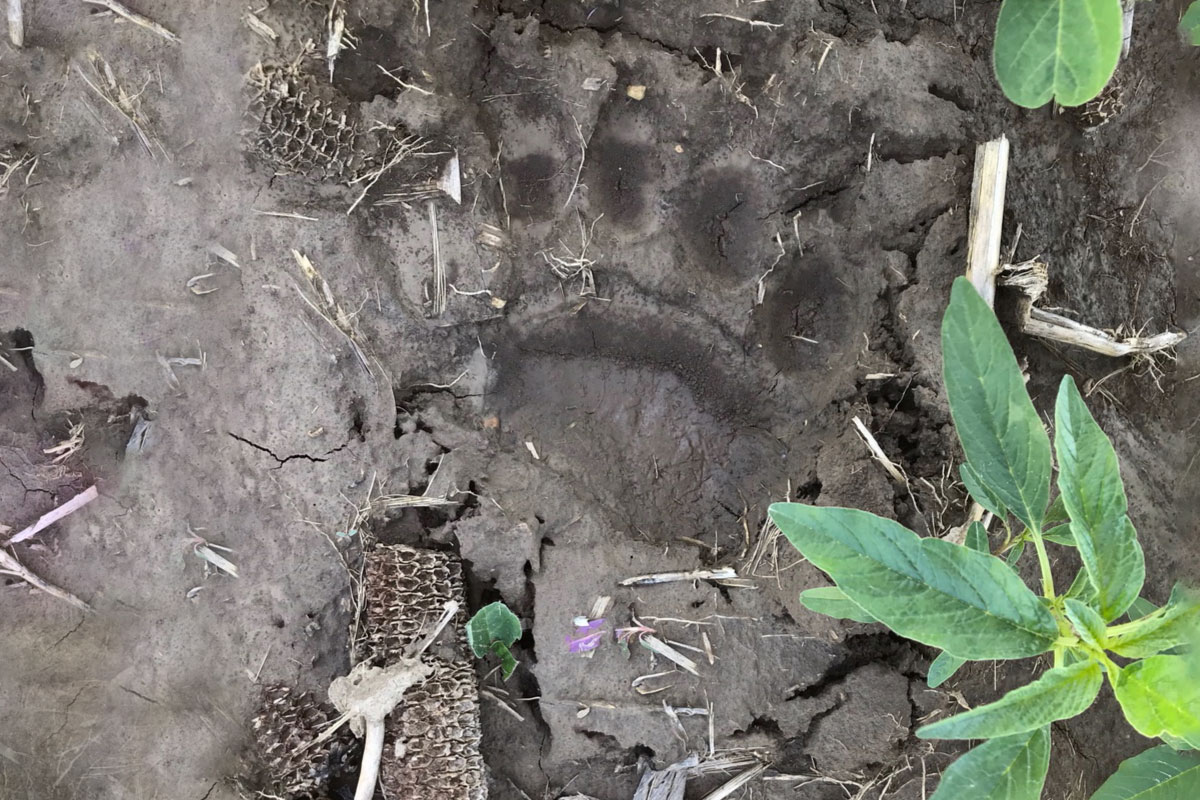
Photo by Jeff Horn District Wildlife Biologist.



Photo by Jeff Horn District Wildlife Biologist.
On June 5, 2020, Dakota Bird, with the USDA Wildlife Services Illinois office, placed a call to Illinois Department of Natural Resources (IDNR) personnel with information of a Wisconsin black bear hanging out near the Illinois-Wisconsin state line. Five days later that bear entered the Prairie State, proceeding on an nearly month-long southbound trek (see map) that involved crossing the Mississippi River into Iowa, another swim back into Illinois and on June 29 its third river crossing, taking it into Missouri.
“The bear certainly found atypical bear habitat on its trek through western Illinois, and was highly visible as it traveled through mile upon mile of corn fields,” explained Stefanie Fitzsimons, IDNR District Wildlife Biologist for Lake, McHenry and Kane counties, who also is the agency’s acting Wildlife Disease and Large Carnivore Biologist.

Fitzsimons described this black bear’s presence as a historic event. Once common in Illinois, black bears were eliminated from the state by 1870 and the 2020 sighting is only the fifth bear sighted in Illinois since 2008. Also significant with this bear was the distance it traveled, and its unfailing southward course.
Based on this bear’s size, biologists estimate it to be a little older than the juvenile males that typically venture on long walk-a-bouts in search of a mate.
“From observations, the bear seemed healthy and well fed so he definitely foraged during his trek,” Fitzsimons explained, noting that bears are omnivorous and at this time of year typically feed on green, emergent and succulent vegetation as well as insects, berries, fish and small mammals, but that agricultural crops do not provide sufficient food during the growing season.
Confirmed sightings of the bear drew crowds of spectators, which concerned wildlife biologists and law enforcement personnel who knew that although black bears are typically timid, the instinct of any wild animal is to protect itself when provoked.
IDNR Conservation Police Captain Laura Petreikis coordinated the bear-watch effort and commended all those involved—Illinois Department of Natural Resources Conservation Police and numerous law enforcement agencies and IDNR biologists—for their work to keep both observers and the bear safe. She also noted the critical role local citizens played in reporting sightings, and the media for their effort in heightening public awareness of the need to minimize stressing the bear and to let it pass through quietly.

“This black bear was extremely tolerant and there were no incidences of aggressive or harmful behavior,” Petreikis remarked. “It did not go through trash or raid gardens, and it did not harm any pets or livestock. We are extremely lucky that this bear had the personality that it did and that most people were respectful of the bear. This bear was a rare occurrence, and likely not to occur on a frequent basis, but we must stress the importance that any bear sighted in Illinois should be treated as you would a bear encountered on your travels into bear country—from a respectful distance.”
Fitzsimons explained that IDNR’s goals were to observe the bear, keep the bear and public safe, and let nature to take its course. In years past, if a bear travelled through an area, it would be days before news could be spread. In this case, social media provided constant locations on the bear, which fueled the formation of crowds at road crossings and limited his ability to settle down and “just be a bear.” Fortunately, nothing went wrong and no people or the bear were harmed.
The agency also stressed to observers that black bears have been protected by the Illinois Wildlife Code since 2015. Black bears may not be hunted, killed or harassed unless there is an imminent threat to person or property. If you feel you or your property is being threatened by a black bear, you should contact the IDNR to learn about options available to address potential threats.

“This certainly was an unusual summer and many people have an incredible story to tell their children and grandchildren of watching a black bear on its journey through Illinois,” Fitzsimons concluded. “The message we want to close with is this—wherever you are, if you see a bear, be respectful, take your picture from a safe distance (more than 100 yards) and move on.”
The story of the Illinois black bear of 2020 may, or may not, be over. Will the bear settle in Missouri? Will it continue to roam and wander back into Illinois? Being a wild animal, only the black bear knows.
What we do know is that wildlife biologists and law enforcement personnel will continue to monitor the region. IDNR welcomes the public’s cooperation regarding reports of bear sightings and appreciates everyone in the area for letting the epic story of one black bear’s journey through the Prairie State play out safely.
To learn more about black bears visit Wildlife Illinois.
Report sightings of black bears to the Illinois Department of Natural Resources.

Kathy Andrews Wright retired from the Illinois Department of Natural Resources where she was editor of OutdoorIllinois magazine. She is currently the editor of OutdoorIllinois Journal.
Submit a question for the author